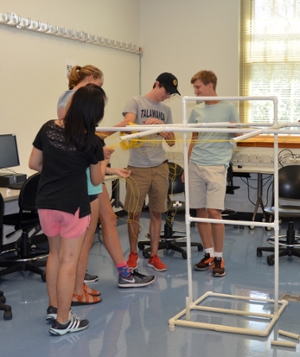Talawanda students build VLF space antenna

 Talawanda students work on their VLF
Talawanda students work on their VLF
antenna
A group of five Talawanda high school seniors are building a VLF space antenna to monitor changes in ion activity in the atmosphere during the solar eclipse of August 21.
Energy from the sun creates a region about 40 miles above us called the ionosphere. The activity in this area is strongly affected by the sun, which, during a solar flare, will expel energy and plasma that will come into the ionosphere. This region is also experiences regular fluctuations in activity over the course of the day based on the rotation of the earth.
To measure the activity, an antenna can be built to measure very low frequency (VLF) radio waves, which bounce off the ionosphere. VLF radio waves are already in the atmosphere because they are created for many reasons, including submarine communications.
The students will use their antenna to measure atmospheric activity on an ongoing basis, but the most exciting activity is expected to occur during the solar eclipse on Monday, August 21. The eclipse will reach its peak in Oxford at about 2:32 pm. The students are eager to see what changes occur due to this rare event.
These students are building the antenna in the engineering building under the guidance of Qihou Zhou, chair of the electrical and computer engineering department. They got the idea for the antenna based on an inexpensive, simple to make antenna developed at Stanford.
Those interested in VLF antennas can build their own using Stanford’s SuperSID Manual.
By Paige Smith

